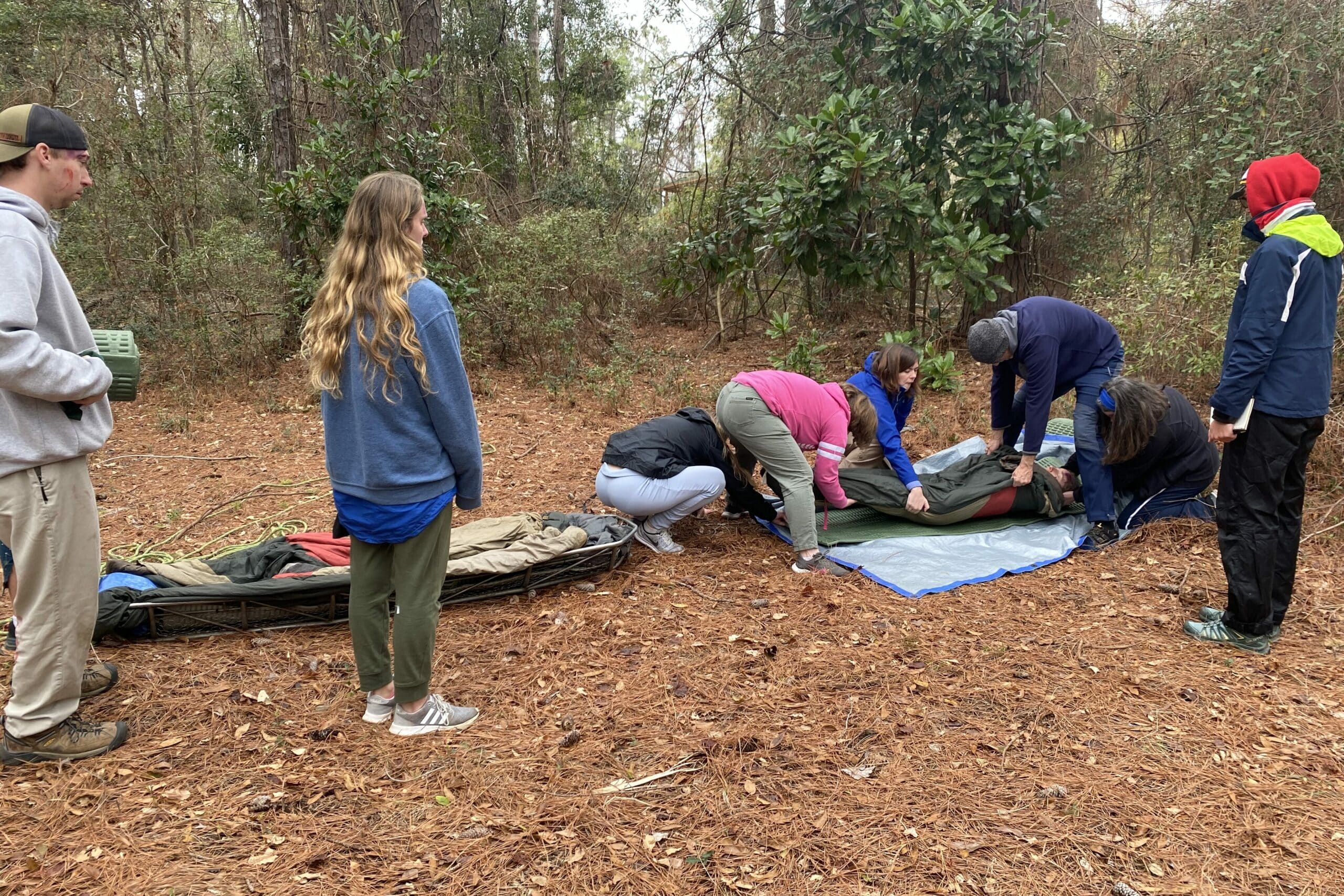New Thinking about How to Handle Spinal Injuries in Remote Wilderness Settings
December 12, 2022
Best practices for evaluating and transporting patients with potential spinal fractures or spinal cord injuries is a hot topic in emergency medicine. And it’s no wonder. All of us who work in the adventure programming and emergency medical services field fervently want to avoid causing or worsening a potentially catastrophic injury to someone’s spinal cord.
As such, and for many decades, EMS officials dogmatically insisted that “immobilizing” patients with potential spine injuries was the best protection from further harm. Protocol demanded rigid backboards, cervical collars, head blocks, and yards of tape and straps to prevent someone who is injured from moving. However, new research suggests this is not only ineffective, but quite likely harmful.

Immobilization Dismissed as the Tool of Choice for Patient Transport
Anyone suffering a spinal injury could have a spinal fracture. And that fracture could be unstable. So, if your client (i.e., patient in this case) moved even a little bit (like turning their head), that unstable spinal fracture could slide around and cause spinal cord injury. And that spinal cord injury could cause them to be paralyzed forever.
The Old School solution was to prevent them from moving on their own. Only let trained first responders (including outdoor educators, field instructors, and guides who are certified in wilderness medicine) lift/move the injured patient. Immobilize them to a rigid device — essentially a full-body splint — and get them out of the backcountry and to a hospital.
Upon what was this edict based? Essentially nothing. A few case reports that, on closer scrutiny, don’t indicate any causal relationship between prehospital patient handling and spinal cord injury.
Why did we do it? Good question. As Dr. Chris Davis, our Medical Director, says, “It’s dogma.” He claims there never was any evidence to using long backboards to support spinal immobilization. We followed that rule because we were taught to do it. We were taught that there was no harm in strapping someone onto the boards with a rigid collar. After all, isn’t it better to be safe than sorry? Problem is, we were wrong.
Latest Research Suggests Spinal Protection Outshines an Unwieldy Spine Board
Over the past 15 to 20 years, research has actually been conducted on rescue best practices, and it shows the following:
- Rigid spine boards and cervical collars are ineffective at “immobilizing” the spine.
- Rigid boards and cervical collars do cause harm. They also delay and complicate the extrication process.
- First responders do a terrible job of not moving a patient’s spine when transferring them from one location to another.
- Patients who are awake and alert do the best job of holding their own spine still when moving from one place to another.
- Spinal protection is the new objective. Essentially, this means being reasonably careful when moving a patient to keep their head/spine in a neutral alignment.
- Conscious and alert patients should be allowed to move themselves when able.
- If the patient must be carried out, vacuum mattresses are the best bet.
In remote wilderness and backcountry settings, evacuation can be dangerous, delayed, and complicated. First responders need to consider the cost/benefit of letting a patient “walk out” versus waiting for help. Depending on the injuries and other factors, delays in getting that patient to a hospital or urgent care facility can be fatal.
Becoming certified as a Wilderness First Responder (WFR) will help prepare you for making decisions on whether to issue a call for help or self-evacuate.
Updated Practical Guidelines for the Protection of Spinal Cord Patients
The Wilderness Medical Society’s Clinical Practice Guidelines for spinal cord protection suggests the following:
- Bleeding and airway/breathing concerns always take precedence over potential spinal cord injuries. Do your best to be careful and limit spinal movement while treating life threats, but don’t let spinal concerns delay care.
- If patients are alert and reliable — not unconscious, confused or panicked — tell them to hold their head still. Let them move themselves to a better location if they are able. You can assist them to move themselves if needed.
- If your patients can’t move themselves or are unconscious, do your best to reduce passive motion of the spine. You can use a sweatshirt or other article of clothing to make an improvised soft cervical collar.
- Placing patients in the recovery position to protect their airway is fine when done with reasonable care to limit passive motion of the head/spine.
- Rigid cervical collars, commercial or improvised, are no longer recommended in the wilderness setting.
You can learn about the latest thinking and practices in backcountry medicine by taking a wilderness medicine course from us here at The National Center for Outdoor & Adventure Education. We offer a number of options and formats for learning about and treating medical emergencies in remote and wilderness settings, including hybrid, on-site, and custom courses offering Wilderness First Responder (WFR), Wilderness First Aid (WFA), and Wilderness EMT certification.
Visit any of the pages linked to above or call our office at (910)-399-8090 during business hours for more information.
– – – – – – – – – – –
About the Author: Kate Javes is a North Carolina Paramedic and a Level 2 EMT Instructor at The National Center for Outdoor & Adventure Education. A former two-sport NCAA Division I athlete at Rutgers University, Kate received her Bachelor of Science degree in math, and a second bachelor’s degree in history from the United States Naval Academy in Annapolis, Md.
TALK TO US
Have any further questions about our courses, what you’ll learn, or what else to expect? Contact us, we’re here to help!
Leave a comment